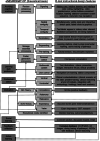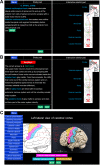eNEUROANAT-CF: a Conceptual Instructional Design Framework for Neuroanatomy e-Learning Tools
- PMID: 34457925
- PMCID: PMC8368470
- DOI: 10.1007/s40670-020-01149-y
eNEUROANAT-CF: a Conceptual Instructional Design Framework for Neuroanatomy e-Learning Tools
Abstract
In an era which is witnessing a significant rise in incidence of neurological diseases, there is also a rise in neurophobia: the diminished confidence of clinical practitioners and students to manage patients with neurological conditions. In this context, the perceived nexus between neuroanatomy-phobia (the challenges and fear associated with learning neuroanatomy) and neurophobia highlighted the need to revisit the neuroanatomy pedagogies and their instructional designs. e-Learning can be effectively employed to enhance students' learning of neuroanatomy. This perspective describes a conceptual framework for online neuroanatomy learning (e-neuroanatomy learning conceptual framework (eNEUROANAT-CF)), which provides a theoretical grounding to newly developed neuroanatomy e-learning resources, by offering a set of instructional design principles. The framework is rooted in the theories of adult learning, cognitive load, and Mayer's theory of multimedia learning. eNEUROANAT-CF was validated by imparting user opinion regarding the best perceived instructional design features for learning neuroanatomy. Furthermore, it was effectively employed to inform the pedagogical construct of an e-tool to help students learn the spinal pathways. The perspective highlights the theoretical underpinnings of the eNEUROANAT-CF under seven categories, namely "avoidance of cognitive overload," "learning style preferences," "contextualization," "motivation," "social learning," "feedback/reflection," and "active learning." In addition, elaborative examples are provided, which explains how eNEUROANAT-CF informed the instructional design features of the abovementioned e-tool. The authors propose that any novel, interactive neuroanatomy e-learning resource rooted in the instructional design principles outlined by the eNEUROANAT-CF will improve users' learning and understanding of neuroanatomy. The research shows promise to help break the perceived nexus between neuroanatomy-phobia and neurophobia.
Keywords: Medical education; Neuroanatomy; Neurophobia; e-Learning.
© International Association of Medical Science Educators 2021.
Conflict of interest statement
Conflict of InterestThe authors declare that they have no conflict of interest.
Figures



Similar articles
-
Neuroanatomy of the spinal pathways: Evaluation of an interactive multimedia e-learning resource.MedEdPublish (2016). 2020 May 4;9:88. doi: 10.15694/mep.2020.000088.1. eCollection 2020. MedEdPublish (2016). 2020. PMID: 38058892 Free PMC article.
-
Understanding neurophobia: Reasons behind impaired understanding and learning of neuroanatomy in cross-disciplinary healthcare students.Anat Sci Educ. 2018 Jan;11(1):81-93. doi: 10.1002/ase.1711. Epub 2017 Jun 19. Anat Sci Educ. 2018. PMID: 28628732
-
Evaluation of Neuroanatomy Web Resources for Undergraduate Education: Educators' and Students' Perspectives.Anat Sci Educ. 2020 Mar;13(2):237-249. doi: 10.1002/ase.1896. Epub 2019 Jun 17. Anat Sci Educ. 2020. PMID: 31095897
-
E-learning in neurology education: Principles, opportunities and challenges in combating neurophobia.J Clin Neurosci. 2017 Oct;44:80-83. doi: 10.1016/j.jocn.2017.06.049. Epub 2017 Jul 8. J Clin Neurosci. 2017. PMID: 28694038 Review.
-
Neuroanatomy, the Achille's Heel of Medical Students. A Systematic Analysis of Educational Strategies for the Teaching of Neuroanatomy.Anat Sci Educ. 2020 Jan;13(1):107-116. doi: 10.1002/ase.1866. Epub 2019 Feb 19. Anat Sci Educ. 2020. PMID: 30702219
Cited by
-
Perception of neurology among undergraduate medical students - what can be done to counter neurophobia during clinical studies?BMC Med Educ. 2023 Jun 16;23(1):447. doi: 10.1186/s12909-023-04405-y. BMC Med Educ. 2023. PMID: 37328733 Free PMC article.
-
An Evaluation of the Design of Multimedia Patient Education Materials in Musculoskeletal Health Care: Systematic Review.JMIR Rehabil Assist Technol. 2024 Oct 15;11:e48154. doi: 10.2196/48154. JMIR Rehabil Assist Technol. 2024. PMID: 39162239 Free PMC article. Review.
-
A Review of the Design of Multimedia Patient Educational Materials in Low Back Pain Research.Phys Ther Res. 2024;27(2):58-66. doi: 10.1298/ptr.R0032. Epub 2024 Jun 28. Phys Ther Res. 2024. PMID: 39257523 Free PMC article. Review.
-
Structured Online Modules and Near-Peer Teaching in Neuroanatomy Stimulate Active Learning and Can Have Beneficial Effects on Medical Students' Scores.Med Sci Educ. 2022 Sep 3;32(5):1077-1085. doi: 10.1007/s40670-022-01617-7. eCollection 2022 Oct. Med Sci Educ. 2022. PMID: 36276771 Free PMC article.
-
Designing multimedia patient education materials for adolescent idiopathic scoliosis: A protocol for a feasibility randomized controlled trial of patient education videos.PLoS One. 2024 May 23;19(5):e0297394. doi: 10.1371/journal.pone.0297394. eCollection 2024. PLoS One. 2024. PMID: 38781168 Free PMC article.
References
-
- Martin K, Bessell NJ, Scholten I. The perceived importance of anatomy and neuroanatomy in the practice of speech-language pathology. Anat Sci Educ. 2014;7:28–37. - PubMed
-
- Mccarron MO, Stevenson M, Loftus AM, Mckeown P. Neurophobia among general practice trainees: the evidence, perceived causes and solutions. Clin Neurol Neurosurg. 2014;122:124–128. - PubMed
-
- Javaid MA, Chakraborty S, Cryan JF, Schellekens H, Toulouse A. Understanding neurophobia: reasons behind impaired understanding and learning of neuroanatomy in cross-disciplinary healthcare students. Anat Sci Educ. 2018;11:81–93. - PubMed
-
- Jozefowicz RF. Neurophobia: The fear of neurology among medical students. Arch Neurol. 1994;51:328–329. - PubMed
LinkOut - more resources
Full Text Sources
